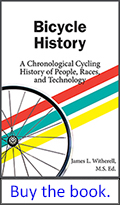

Patents and Bikes
by John Neugent
The late John Neugent probably knew more about bicycle wheels than anyone else. Maybe more about bikes as well. He spent his life in the bike business, at every level. He owned Neugent Cycling, a firm devoted to delivering world-class equipment at the lowest possible price. —Chairman Bill

John Neugent

James Witherell's book Bicycle History: A Chronological History of People, Races and Technology is available in both print and Kindle eBook formats. Just click on the Amazon link on the right.
John Neugent writes:
I am not a patent attorney so all of my experience comes from the school of hard knocks. This article is not meant to provide legal advice but rather to give you an idea of what patents are and how the system works.
Maybe you, like so many of us, have a great idea and want to patent it. It’s actually not that difficult in its simplest form. The real problems come if the idea is successful and you have to defend it.
There are basically two types of patent. A design patent and a utility patent. The design patent protects the ornamental design or appearance of a product. The utility patent protects a functional improvement on an existing product or an entirely new product. For the purpose of this article I will only address the utility patent
It’s extremely simple and inexpensive to file a provisional patent. This gives you protection for a year and allows you to claim “patent pending.” In fact, I recommend doing this fairly early because by filing, you have some legal protection and you can find out if you can actually sell your new idea before you have put too much effort into it. Be aware though that after you file you have one year to file “the real” patent.
The first thing you need to do is find out if your idea has been done, or for that matter, already patented. Many bicycle related ideas are already covered by patents. So much so that the first place some large corporations look for new ideas are in patent files.
www.jimlangley.net/ride/bicyclehistorywh.html
William Hudson in his great article (use link above here) Myths and Milestones in Bicycle Evolution writes, "….It’s worth noting that Jim Hurd, the former curator of the Bicycle Museum of America, says that at the turn of the century there were two buildings in Washington DC that held every patent in the U.S. One building held patents covering every type of product you can think of. The other building was reserved specifically for bicycle patents. The late English cycling historian, John Pinkerton, once remarked, 'Think of a new idea in bicycle design and someone will have already invented it, probably in the nineteenth century'.”
The best place to check for patents is on the Patent and Trademark site www.uspto.gov/patents/search. You can easily search patents by different criteria. One helpful hint in doing quick searches is to look at the cover page image and abstract. That will cover most of it. Any design patents have a D before their number.
Once you have done your homework (and this should include Internet searches and magazine articles and any other source you can think of for similar products) and find there is no prior art or patents, you can file a provisional patent which is a very short form of the idea and is not required to follow general patent requirements.
At this point I highly recommend going to www.nolo.com/. Nolo is an excellent source for all legal advice and gives you low cost options. I incorporated a company using only their advice and forms. I would recommend, if your idea really seems to be a winner, to hire a patent attorney for the real patent filing (the one after the provisional).
Assuming your product is a hit and you want to move forward with the formal patent filing it’s important you learn how to translate your idea into “patent speak.” When you first start reading patents it’s like learning a new language. But you can cut to the quick if you know a few of the basics.
The core of any patent are its claims. It’s important you understand this part because your patent attorney will not know your invention as well as you do and could create weaker claims than you would if you learn the logic behind the claims.
The claims are a MINIMAL list of requirements that makes your product unique.
Generally, the fewer claims, the stronger the patent because for a product to infringe on patent it must have all of the claims referred to in the patent.
A claim may read like this: A bicycle saddle with two holes in the top, one being round and rearward and the other being oval and forward.
If you have a saddle that has an oval hole rearward and an oval hole forward you do not infringe.
A stronger patent would claim “a saddle with one or more holes.”
There is a gray area called “the doctrine of equivalents” that says if your product is “similar” to the claims of a prior patent you infringe. Of course, that would have to be decided by litigation.
Which brings me to the core of patents. I was once told by a lawyer of a large bicycle company that an inexpensive patent lawsuit would cost $100K. Therefore, even with a strong patent and an excellent product, large companies can and will infringe on your patent if you don’t have the resources to enforce it. There are a plethora of legal tools they can use to force you to spend huge amounts of money in legal fees long before the case goes to trial.
Of course, not all companies do that, but be aware that our legal system strongly favors people with lots of money and allows them to bully people without it. As the saying goes “How much justice can you afford?”
Also be aware that a U.S. patent only covers the U.S. Anyone in another country is free to make your product and distribute it. With the Internet and websites like www.Alibaba.com national boundaries are quickly becoming transparent. You can file patents in other countries but even the big companies will generally only select their key markets.
Note that if you really feel you are going to hit a home run with your idea the European market is larger than the US for quality bicycle products and should not be forgotten. And yes, that one year protection that your provisional patent covers also applies to Europe
But patents are not just for registering unique ideas. They are also a great way to come up with new product ideas. Often expired patents have great concepts that can be enhanced using new technology. Adding new technology to old patents is often patentable.
It’s not uncommon, when new technology arises, for people to file large numbers of patents for its application on different products. For example, if I invented a new class of super lubricant, I could file patents for its use on bicycles, motorcycles, cars, and anything else I could come up with.
If you have a great idea, it’s easy and relatively inexpensive to protect it for a year with a provisional patent. If your product is a huge success it's possible companies with a lot of money will steal it, but it’s also possible they won’t and if you make a lot of money you can fight them.
I am not a lawyer and this article should not be considered legal advice.
Thanks for reading – John Neugent
John Neugent was was one of the first to establish quality hand building in Taiwan around the turn of the century. He now owns Neugent Cycling, a firm devoted to delivering world-class equipment at the lowest possible price.







